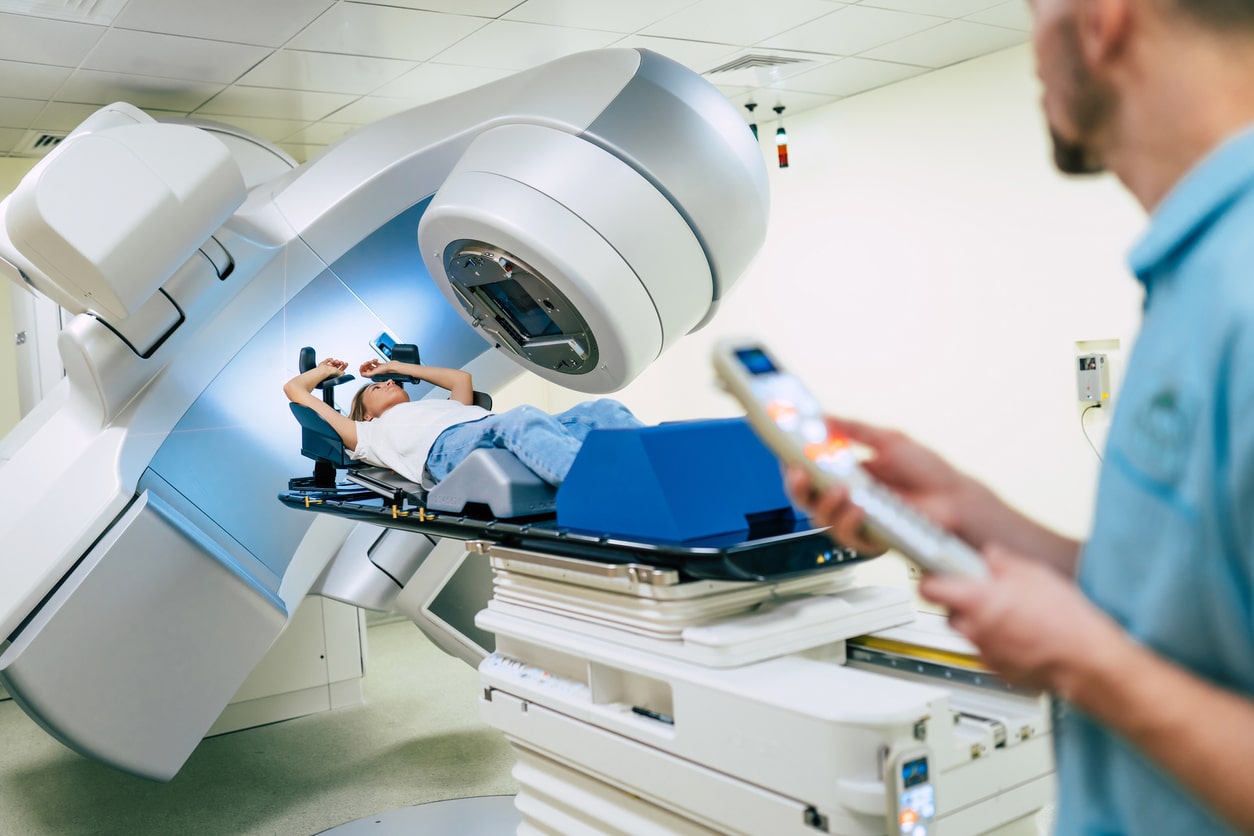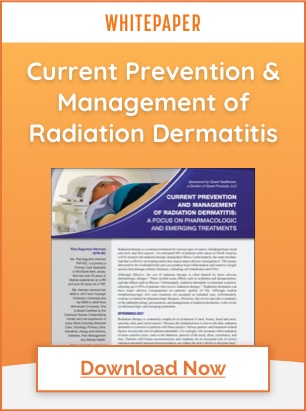
Prevention & Management of Radiation Dermatitis in Cancer Patients
An estimated 4 million people per year receive radiation therapy1, and of those up to 95% of patients2 will experience radiation-induced dermatitis (RD).
Chronic or acute skin damage from RD can lead to treatment delays, diminished treatment outcomes, and reduced quality of life both during or after treatment. Managing skin injury due to radiation therapy is a critical aspect of overall cancer care.
Recent research suggests that topical products support, protect and promote tissue repair in patients with radiation dermatitis2.
Radiation Therapy for Cancer
More than half of all cancer patients3 receive radiation therapy as part of their treatment protocol. It can be used alone or in conjunction with other treatments, and the type and stage of cancer, as well as any underlying health problems, determine whether radiation therapy will be effective. Every patient and each cancer is different, but it is most often employed to:3
- cure or shrink early-stage cancer
- treat recurrent cancer
- prevent cancer from coming back
- treat symptoms caused by advanced cancer
Cancer Radiation Impact on the Skin
Radiation dermatitis (known commonly as radiation burn) is a frequent and painful side effect of external beam radiation therapy, which passes through skin to the targeted area. Studies show that RD is most common in patients with breast, head and neck, skin, or anal cancer.1
Radiation dermatitis is characterized by an acute skin reaction that occurs at or around the time of radiation therapy as well as chronic or late onset dermatitis that can occur months or even years after treatment.2
The acute phase of RD is defined by lesions in the skin that appear within 90 days of the start of radiation therapy. It typically first presents as transient erythema (redness of the skin). As therapy progresses, skin dryness, pain, and hyperpigmentation may appear. Towards the end of treatment, RD symptoms include scaling, itching, peeling, and increased pain.2
Chronic RD occurs when skin reactions occur more than 90 days after the completion of radiation therapy. These include thinning of the skin, dermal atrophy, fibrosis, edema, keratosis, telangiectasia, and dermal necrosis.
Risk of Developing Radiation Induced Dermatitis
The severity and likelihood of a patient developing RD depending of several factors4, including:
- Radiation dose and treatment schedule
- Proximity of radiation target to the skin
- Energy of the radiation
- Presence (or not) of radiosensitizing concurrent chemotherapy
- The amount of skin surface area exposed to radiation
Other factors that can increase the severity and risk of RD include obesity, connective tissue or vascular disease, genetic factors, smoking, and malnutrition.4
Assessment and Diagnosis of Radiation Dermatitis
The most commonly used scale in the United States for the assessment and diagnosis of RD5 is the National Cancer Institute (NCI) Common Toxicity Criteria for Adverse Events (CTCAE).6 This scale divides acute RD symptoms into five ‘grades’ of reactions 6:
Grade 1: slight redness, rash, or dry desquamation of the skin that appears within the first 2-4 weeks of treatment. Skin may feel sensitive or tight.
Grade 2: increased redness/rash, itching, flaking, moist desquamation in skin folds, and/or a patchy appearance in the skin.
Grade 3: Bleeding, abrasions or other minor trauma to the skin, and/or moist desquamation in areas other than skin folds or creases.
Grade 4: Potentially life-threatening side effects such as skin necrosis, spontaneous bleeding, or full-thickness skin ulcers.
Grade 5: Death
Prevention and Management of RD
Daily topical skin treatment can help relieve symptoms and severity of RD if employed from the start of radiation therapy.2 It is essential for providers and caregivers to perform a regular skin care assessment throughout the course of radiation treatment and beyond.
Other prevention and treatment measures7 patients can take include:
- Gently washing the affected area daily with warm water
- Avoid antiperspirant and talcum powder
- Avoid perfumed or heavy soaps – a low-PH cleanser without perfumes or dyes is preferable
- Follow all wound care as directed
- Avoid products that stick to the skin, such as medical supplies with adhesive, stick-on bandages, nicotine patches, and medical tape
- Avoid sun exposure and extreme temperatures
- Do not shave the affected area
- Wear clothing that fits well – not too tight or too loose
Download our Current Prevention & Management of Radiation Dermatitis White Paper today to learn more about diagnosis, treatment and prevention options.
Treating Radiation Dermatitis with ALOCANE® Plus
Radiation dermatitis can be painful and negatively affect health-related quality of life and healthcare costs. ALOCANE® Plus is an effective treatment for the temporary relief of minor pain and itching associated with radiation dermatitis.
ALOCANE® Plus is a topical ointment containing 4% lidocaine (a topical analgesic) and 0.13% benzalkonium chloride (a topical antiseptic), along with other ingredients such as aloe vera and tocopheryl acetate (vitamin E). Lidocaine is a local anesthetic that exerts its analgesic effects through the inhibition of voltage-gated sodium channels in neurons, thus preventing the generation and conduction of nerve impulses. Benzalkonium chloride significantly reduces germs commonly associated with skin infections. Read all package directions before use.
Request an complimentary, educational In-Service for your radiation therapy team today!
Disclaimer: The material contained is for reference purposes only. Quest Healthcare, A Division of Quest Products, LLC, does not assume responsibility for patient care. Consult a physician prior to use. Copyright 2023 Quest Healthcare, A Division of Quest Products, LLC.
SOURCES:
-
- Radiation Burn (Dermatitis): What it is, Treatment, Management (clevelandclinic.org)
- Topical treatment of radiation-induced dermatitis: current issues and potential solutions – PMC (nih.gov)
- How Radiation Therapy Is Used to Treat Cancer
- Radiation Dermatitis: Recognition, Prevention, and Management (cancernetwork.com)
- Understanding radiation dermatitis (myamericannurse.com)
- Common Terminology Criteria for Adverse Events (CTCAE) (cancer.gov)
- How to care for your skin during and after radiation therapy (aad.org)







